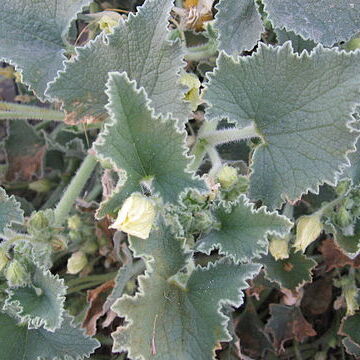Herbs, creeping. Roots perennial. Stem and branches setose. Tendrils absent. Leaf blade cordate. Plants monoecious or dioecious. Male inflorescence a raceme; calyx tube shortly campanulate; segments 5, linear-lanceolate; corolla yellow, broadly campanulate or almost rotate; segments ovate-oblong, apex acute; stamens 3, linear; filaments short, free; anthers: one 1-celled, two 2-celled; anther cells reflexed; connective broad, not produced; pistillode absent. Female flowers solitary; calyx and corolla as in male flowers; staminodes 3, ligulate; ovary oblong, hispid; ovules numerous, horizontal; style short; stigmas 3, 2-lobed. Fruit oblong, hispid, scabrous, watery inside, when mature separating from peduncle and contracting at base, dispersing seeds by elastic contraction (squirting seeds). Seeds numerous, brown or nearly black, oblong, compressed, narrowly marginate.
Monoecious trailing herbs, fleshy, hispid, perennial with thickened rootstock. Tendrils absent. Leaves simple, triangular to ovate, cordate, undulate. Male flowers in axillary bracteate racemes; hypanthium broadly campanulate; calyx 5-lobed, the lobes lanceolate; corolla deeply 5-lobed, the lobes ovate, acute, yellow; stamens 3, inserted on hypanthium; anthers all bilocular; locules flexuose, triplicate; disc absent. Female flowers solitary, sometimes co-axillary with males; perianth similar to males; staminodes absent; ovary ellipsoidal, setose; ovules many, horizontal; stigmas 3, bifid, subulate, recurved. Fruit ellipsoidal, juicy at maturity, bristly, dehiscing actively through ruptured attachment of pedicel. Seeds numerous, ovate, smooth.
Monoecious herb with prostrate, hispid stems. Rootstock stout and ± tuberous. Tendrils 0. Lvs lobed. Fls axillary, 5-merous, pale yellow; ♂ in racemes; ♀ solitary. Calyx tube very short. Petals united towards base. Stamens 3, free, with broad connectives. ♀ fls with 5 staminodes. Ovary hispid, minutely tuberculate; placentae 3; ovules numerous; stigmas 3-(4), each forked. Fr. oblong-ellipsoid, scabrid and densely hairy at maturity, becoming detached from peduncle and violently ejecting the seeds from the resulting aperture. Seeds numerous, ovate-ellipsoid, dark brown; margin obscure.

